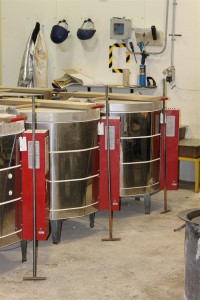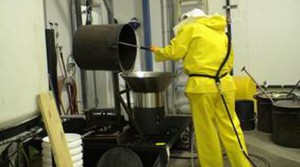Caustic Dissolution
 Our Caustic Dissolution process utilizes total liberation techniques to provide an accurate portrayal of diamond distribution within rock. Sample sizes can range from grams to hundreds of kilograms. The caustic process uses an industry standard method to achieve the highest and most accurate results. Samples of up to 8 kilograms can be loaded into each of our 6 kilns for up to 48 kg of material a day. The sample is placed into a large steel crucible, or if warranted, divided up into multiple crucibles and caustic soda is added to dissolve the rock.
Our Caustic Dissolution process utilizes total liberation techniques to provide an accurate portrayal of diamond distribution within rock. Sample sizes can range from grams to hundreds of kilograms. The caustic process uses an industry standard method to achieve the highest and most accurate results. Samples of up to 8 kilograms can be loaded into each of our 6 kilns for up to 48 kg of material a day. The sample is placed into a large steel crucible, or if warranted, divided up into multiple crucibles and caustic soda is added to dissolve the rock.
The dissolution process takes place over many hours in temperature controlled kilns. The extreme heat and caustic soda reduce the sample to molten rock. Once the reaction between the rock and the caustic soda is complete, the residue is then cooled and dissolved in water. The slurry created is then poured through a high quality, single-use stainless steel screen. Once the sample has been recovered from the screen it is determined whether further dissolution is required in order to achieve total liberation of diamonds from the host rock.
All samples undergo a micro fusion to further clean the sample prior to observation. In the case where abundant oxides remain in the residue, additional  dissolutions can be performed using a variety of chemicals to reduce the size of the concentrate prior to observation without harming the diamonds. QA/QC measures are heavily used during the caustic process. Photographs of the samples are taken upon sample receipt and also at various stages during its processing. Quality control grains are added to each and every aliquot that undergoes the caustic dissolution process. Ten high quality synthetic diamonds ranging from 0.18mm to 1.0mm are added to every pot and recovered at the observation stage.
dissolutions can be performed using a variety of chemicals to reduce the size of the concentrate prior to observation without harming the diamonds. QA/QC measures are heavily used during the caustic process. Photographs of the samples are taken upon sample receipt and also at various stages during its processing. Quality control grains are added to each and every aliquot that undergoes the caustic dissolution process. Ten high quality synthetic diamonds ranging from 0.18mm to 1.0mm are added to every pot and recovered at the observation stage.

